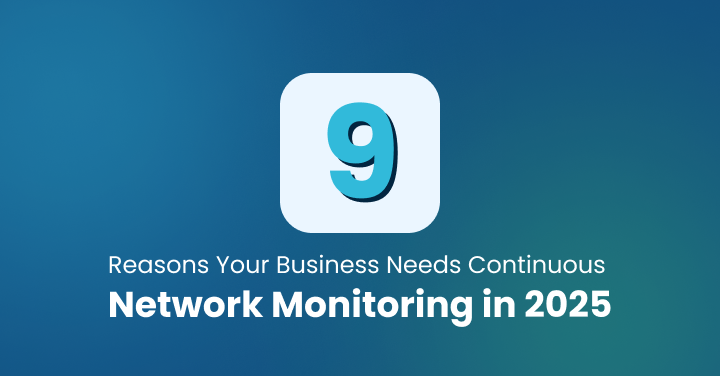Introduction: The Language of a Healthy Network
Imagine this: it’s a busy workday, and your organization’s network suddenly goes down. Customer transactions fail, employees lose access, and support tickets start piling up. Every passing minute affects productivity, costs money, and impacts your company’s reputation.
This is where network monitoring becomes critical. Network monitoring is the process of continuously tracking, analyzing, and optimizing devices and traffic across the network to maintain uptime and performance.
But here’s an important truth: no single protocol can handle every aspect of network monitoring. Each protocol serves a unique purpose — from checking device health to tracking traffic or recording system events.
A strong network monitoring strategy brings these protocols together to provide a complete view of your network’s health. Let’s explore the key protocols that make this possible.
1. Device Health and Status — The “Heartbeat Check”
Every network device, from a router to a switch, plays a vital role in maintaining seamless connectivity. But how do you know if each of these devices is healthy and performing well?
That’s where device health and status monitoring comes in. It’s like checking a patient’s heartbeat — ensuring that all systems are running as expected before something goes wrong.
Two core protocols form the foundation of this monitoring approach: SNMP (Simple Network Management Protocol) and ICMP (Internet Control Message Protocol). Both work together to help IT teams detect issues early, understand device conditions, and keep the network stable.
A. Simple Network Management Protocol (SNMP): The Industry Workhorse
What it is:
SNMP is one of the most widely used and time-tested network monitoring protocols. It’s built into almost every kind of device you can think of — routers, switches, servers, firewalls, and even printers.
Its job is to help network administrators collect and organize information about these devices so they can monitor their health and performance.
How it works:
SNMP uses a manager-agent model, which is a simple and efficient way to exchange information.
- The Manager, also known as the Network Management System (NMS), is the central monitoring tool. It requests data from devices across the network.
- The Agent is a small service running on the devices. It collects information like CPU usage, memory levels, interface status, and stores it in a structured database called the Management Information Base (MIB).
SNMP communication happens in two ways:
1. Polling:
The NMS regularly sends requests to devices, asking for performance data. For example, it might ask, “What is your CPU load right now?” or “How much bandwidth are you using?” This method gives continuous updates about the device’s current condition.
2. Traps:
Instead of waiting for a request, devices can automatically send alerts to the manager when something unusual happens — such as a port going down, temperature exceeding a limit, or power failure. Traps allow faster reaction to unexpected issues.
SNMP Versions:
Over time, SNMP has evolved to improve its security and reliability.
- SNMP v1 and v2c: These are early versions that provide the basic functions of device communication and monitoring. However, they offer minimal security, as they rely on community strings that can be intercepted if not properly secured.
- SNMP v3: The most secure and modern version. It adds encryption and authentication, ensuring that the data exchanged between devices and monitoring systems is safe from unauthorized access.
Use Case:
SNMP is the backbone of network monitoring. It’s ideal for:
- Tracking device health, uptime, and resource usage.
- Detecting early hardware or configuration failures.
- Maintaining network stability and preventing outages.
SNMP allows IT teams to keep their networks in check by constantly monitoring performance metrics and getting notified before minor issues turn into major disruptions.
B. Internet Control Message Protocol (ICMP): The Basic Pinger
What it is:
ICMP is a simpler protocol compared to SNMP but serves a very specific purpose. It operates at the network layer and helps test connectivity between devices.
How it works:
ICMP powers two of the most commonly used network troubleshooting tools: Ping and Traceroute.
- Ping sends small packets of data from one device to another and measures how long it takes for the packets to return. This helps determine if a device is reachable and how responsive it is.
- Traceroute tracks the exact path that packets take to reach their destination. This can help identify where in the network delays or failures occur.
Use Cases:
- Checking whether a device, such as a router or server, is online.
- Measuring latency, packet loss, or overall network responsiveness.
- Diagnosing where communication breaks down between two points in the network.
Limitation:
While ICMP is great for confirming whether devices are up and responding, it doesn’t provide deeper insights like CPU load, bandwidth usage, or memory utilization. It’s like knowing that a person is alive because you can feel their pulse, but not knowing how healthy they are internally.
In summary:
ICMP is an essential diagnostic tool. It provides a quick check of network connectivity, but it should always be used alongside other protocols such as SNMP for complete visibility and performance insights.
2. Traffic and Flow Analysis — The “Traffic Report”
Monitoring devices alone isn’t enough. Even if every router and switch is healthy, your network can still experience slowdowns, congestion, or security issues if the traffic flowing through it isn’t properly understood. That’s where traffic and flow analysis protocols come into play.
These protocols help IT teams understand how data moves within the network, who is using it, and how much bandwidth each application or user consumes.
This deeper insight helps in managing performance, capacity planning, and even detecting suspicious activities.
A. NetFlow, sFlow, and IPFIX: Understanding What Travels Through Your Network
What they are:
NetFlow, sFlow, and IPFIX are protocols designed to collect and analyze metadata about network traffic.
Instead of inspecting the actual data being transmitted, they summarize details such as who is communicating, for how long, and over which ports or protocols.
- NetFlow: Originally developed by Cisco, NetFlow is widely used across enterprise environments to analyze IP traffic and support capacity planning.
- sFlow and IPFIX: These are vendor-neutral alternatives that provide similar capabilities and work across different types of devices and network infrastructures.
How they work:
Network devices like routers and switches generate and export flow records, which are small summaries of traffic sessions passing through them. These flow records contain valuable details, including:
- Source and destination IP addresses and ports.
- Protocols used (for example, TCP, UDP, or ICMP).
- The total volume of data transferred.
- Duration of the connection or session.
The collected data is then sent to a central flow collector, which organizes and analyzes it to reveal trends, performance issues, and anomalies.
Use Cases:
- Bandwidth Management: Identifying which users, departments, or applications consume the most bandwidth.
- Traffic Optimization: Understanding usage trends to optimize performance and allocate resources more efficiently.
- Security Monitoring: Detecting suspicious activities, such as sudden spikes in traffic, potential data breaches, or distributed denial-of-service (DDoS) attacks.
Why it matters:
Flow-based monitoring gives IT teams a clear picture of how data moves through the network. This visibility allows them to troubleshoot performance issues faster, plan for growth, and improve user experience.
Instead of reacting after a problem occurs, they can spot trends and fix issues before users even notice them.
3. Event Logging and Modern Monitoring Techniques
Monitoring the performance and traffic of devices provides valuable insights, but true network observability requires understanding what’s happening behind the scenes. This is where event logging and next-generation monitoring techniques come in.
A. Syslog: The Event Recorder
What it is:
Syslog is a universal logging protocol that helps collect and centralize event messages from devices, servers, and applications across the network. It creates a single source of truth for all system and network activities.
How it works:
Each device sends text-based log messages to a central Syslog server. These messages describe what’s happening within the device — from normal operations to warning alerts or errors. Administrators can review these logs manually or use automation tools to analyze patterns and detect issues.
Use Cases:
- Security Auditing: Helps track access logs, failed login attempts, and potential intrusions.
- Configuration Tracking: Records configuration changes, allowing teams to know who made what change and when.
- Error Detection: Logs errors or warnings that help in diagnosing performance issues or failures.
Syslog often works alongside SNMP traps and Security Information and Event Management (SIEM) tools to provide both operational and security insights. This combination allows teams to quickly correlate events, detect incidents, and ensure compliance.
B. Streaming Telemetry: The Future of Monitoring
What it is:
Streaming telemetry represents the next step in network monitoring technology. Instead of the traditional “pull” model used by SNMP (where the monitoring tool requests data), telemetry uses a push-based approach. Devices continuously send detailed metrics to a central collector in real time.
Key Benefits:
- Real-Time Updates: Provides continuous data streaming, offering insights that update multiple times per second.
- High Granularity: Delivers much more detailed and precise information than older polling methods.
- Scalability: Easily handles large volumes of data from modern hybrid and cloud environments.
- Security: Uses secure and efficient transport methods such as gRPC and TLS to protect data in transit.
Why it matters:
Streaming telemetry enables organizations to move from periodic monitoring to truly real-time observability. It supports predictive analytics and AI-driven insights, helping IT teams identify and fix issues before users are affected.
As networks become more complex and dynamic, streaming telemetry will continue to shape the future of network performance monitoring.
Conclusion: Building a Multi-Protocol Strategy
There is no single protocol that can handle all aspects of network monitoring. True network visibility comes from combining several protocols, each contributing unique data and insights.
- SNMP tracks device health and status.
- ICMP ensures connectivity and helps identify reachability issues.
- NetFlow, sFlow, and IPFIX analyze traffic patterns and bandwidth usage.
- Syslog captures detailed logs and event histories.
- Streaming telemetry brings real-time precision and scalability to modern monitoring.
Together, they create a comprehensive monitoring framework that helps IT teams detect, diagnose, and resolve problems faster.
Actionable Takeaway:
To build an effective monitoring strategy, organizations should use unified monitoring tools that integrate data from all these protocols. Such tools act as a single source of truth for network performance, security, and availability.
By combining these protocols, businesses can move beyond simple uptime checks and build smarter, more resilient networks that support business growth and reliability.
FAQs
SNMP. It collects detailed resource metrics such as CPU usage, memory, and network interface performance.
SNMP focuses on monitoring device health and performance. NetFlow focuses on analyzing how data moves across the network and how much bandwidth it consumes.
Yes. SNMP v3 adds encryption and authentication, which protect monitoring data from being intercepted or tampered with.
No. ICMP is great for basic connectivity checks but cannot measure deeper metrics such as performance, device utilization, or network congestion.






